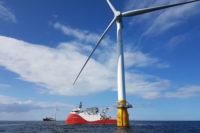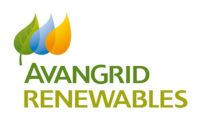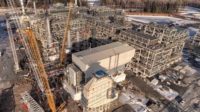Federal regulators released draft environmental impact statements in mid-December for two more east coast offshore wind energy projects—including one that is set to be both the largest in the U.S. and the first to be utility-owned, and which also gained a key state approval related to development cost risks.
The U.S. Interior Dept said the initial environmental reviews of the 2.6-GW Coastal Virginia Offshore Wind project to be built off Virginia Beach and the 1-GW Sunrise Wind project off the Long Island, NY coast—which assess their submitted construction and operations plans—were published in the Federal Register on Dec. 16 with a 60-day comment. The department said the Virginia project, being developed by utility firm Dominion Energy, could gain a record of decision by June, with Sunrise potentially getting its final okay by next August.
“This is a major milestone and transformation for the Hampton Roads economy,” said Dominion Energy CEO Bob Blue, noting that it keeps the nearly $10-billion project on time and on budget. The firm has signed about $6.9 billion in supplier contracts, with added major investment in supporting port manufacturing development.
In an even more significant approval, Virginia regulators on Dec. 15 okayed the first $73 million in project costs to be recovered through customer rates, in an order that also includes performance standards in future project construction cost sharing and operation. Further costs must be approved by the State Corporation Commission.
Project De-Risking
“The magnitude of this project is so great that it will likely be the costliest project being undertaken by any regulated utility in the United States," the commission emphasized, despite the approval, also noting the expected high cost of electricity produced.
The performance guarantees, meant to shield ratepayers from potential construction cost overruns, were developed as part of an Oct. 28 settlement between the utility and stakeholders but not acted on by the commission.
In its approval, the regulator said the settlement "adequately protects the interests of consumers" and it could find no stakeholder "opposition" to its green light.
“We expect over 90% of the project costs, excluding contingency, to be fixed by the end of the first quarter in 2023 as compared to about 75% today, further de-risking the project and its budget,” Blue said.
The clean energy project is expected to save Virginia customers $3 billion during its first 10 years in operation, and possibly up to $6 billion, if commodity market pressure continues for fuel from traditional generators, he said.
Dominion’s project includes 176 Siemens Gamesa-manufactured wind turbines, each rated at 14.7 MW, and three offshore substations. Construction is set to begin in 2024 and take three years.
The draft EIS found mostly minor impacts from the project but noted some larger ones that could affect commercial fisheries, marine mammals and scientific research and surveys.
Light of Day for Sunrise Wind
The draft review for Sunrise covers a project that will have about 84 planned wind turbines, each with a generating capacity of 11 MW, and one 105-mile, 320-KV DC export cable bundle that connects with an onshore substation in Holbrook, N.Y.
Developer firms Orsted and utility Eversource said the project would create about 800 construction jobs and generate new investments in workforce training and infrastructure.
The firms are providing $75 million toward an estimated $250-million project to develop a New London, Conn., port site into an offshore wind staging and assembly hub for the project. The facility also would support the joint venture's 137-MW South Fork and 704-MW Revolution Wind projects. Contractor Kiewit is its construction manager, with AECOM as construction administrator.
The overall wind project, also supported by Con Edison and the New York Power Authority, is set to be fully operational in 2025. Interior's review says its cumulative effect on fisheries could be major. The agency will use the draft reviews to decide whether to issue final project okays and to set any mitigation steps that must be taken.
Two approved U.S. offshore wind projects now are in construction—the 800-MW Vineyard Wind off Massachusetts being developed by Copenhagen Infrastructure Partners, and South Fork. Contractor Prysmian Group began Vineyard Wind's cable installation in November, which will continue through early 2023, the company said. The project is planned to begin generating power in late 2023.
Cable construction to connect South Fork to the onshore grid at Easthampton, N.Y., also is underway with the wind project set to operate also late next year.
A 180-ft by 130-ft jack-up vessel built by Gulf Island Marine Fabricators and owned by Seacor Marine, both Louisiana-based oil and gas sector veterans, is being deployed for directional drilling and conduit construction along the coastline, says a report by industry publication Recharge.
New York, which has set a 2035 mandate for 9 GW of offshore wind, plans a third procurement round next year for at least 2 GW.
Port Support Presses On
Meanwhile construction site preparation work has resumed for a $350-million offshore wind supply chain hub at Albany, N.Y., on the Hudson River.
The $357 million facility, which is being built by a joint venture of Canada-based tower manufacturer Marmen and Danish manufacturer Welcon to support projects being developed by the U.S arm of Norwegian firm Equinor and BP, its energy firm partner, would be located on an 81-acre artificial island.
Work was halted by the US Army Corps of Engineers last spring after trees were clear-cut without federal permits for that purpose. The early site work now is set to continue into 2023, and will generate around 500 jobs, according to developers.
Towers will be built at the facility and transported on the river to a marine terminal in Brooklyn before final offshore project placement. The site now is undergoing a $250-million expansion. “This is an exciting step in moving forward with the project,” said Port of Albany CEO Richard Hendrick.
The port is targeting construction completion in 2025, with manufacturing equipment to be installed in 2024. The Equinor-BP Empire and Beacon offshore wind projects are set to produce 3.3 GW of power.
Despite the progress, supply chain and port capacity shortfalls are expected to be a key issue for offshore wind development, according to a report from University of Delaware earlier this year. It forecasts a 191-acre laydown shortage—equivalent to 3.5 GW of capacity over an 18-month construction season—annually starting next year.
The researchers cite “developers having built ports to support early, smaller projects, and having located them to incentivize state power contracts rather than ... for long-term, large-scale and economically-efficient use.”
The study recommends a state-led regional approach to port development that could maximize economies of scale.







Post a comment to this article
Report Abusive Comment